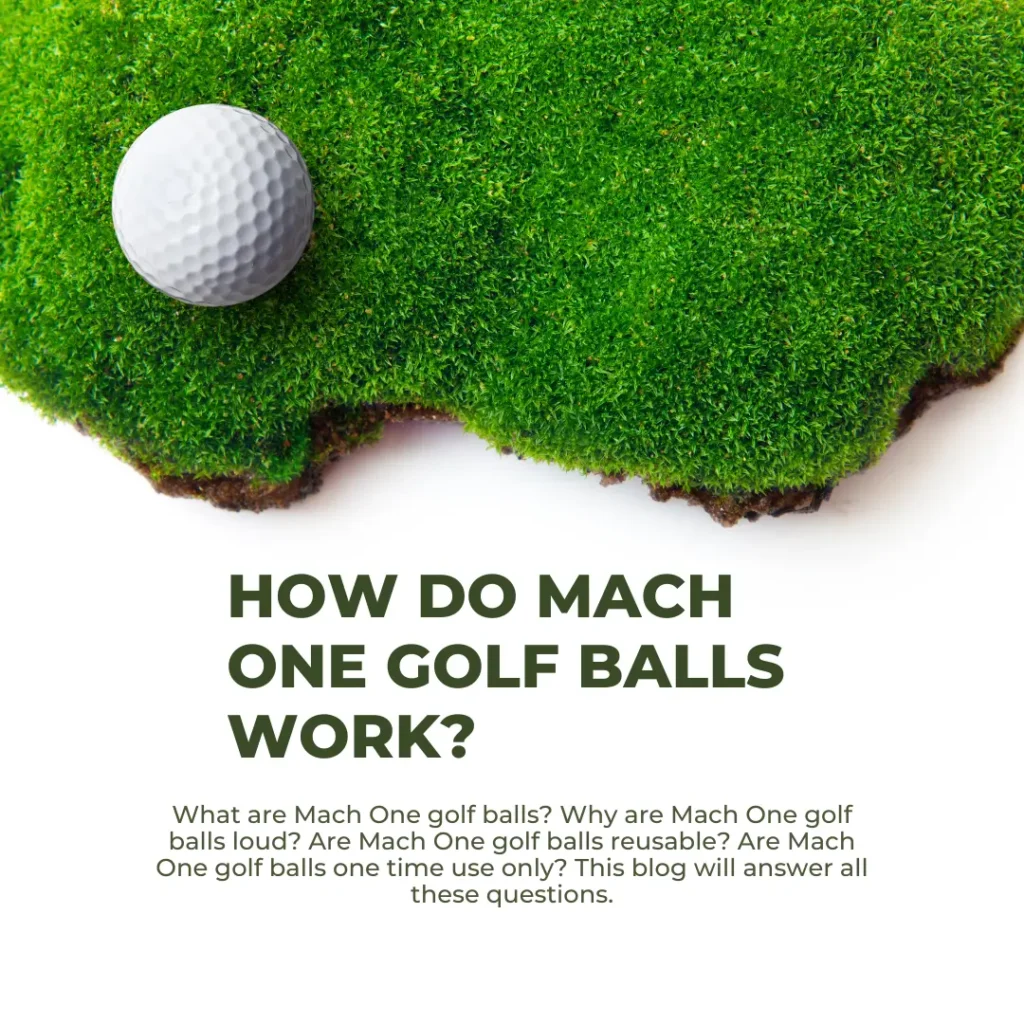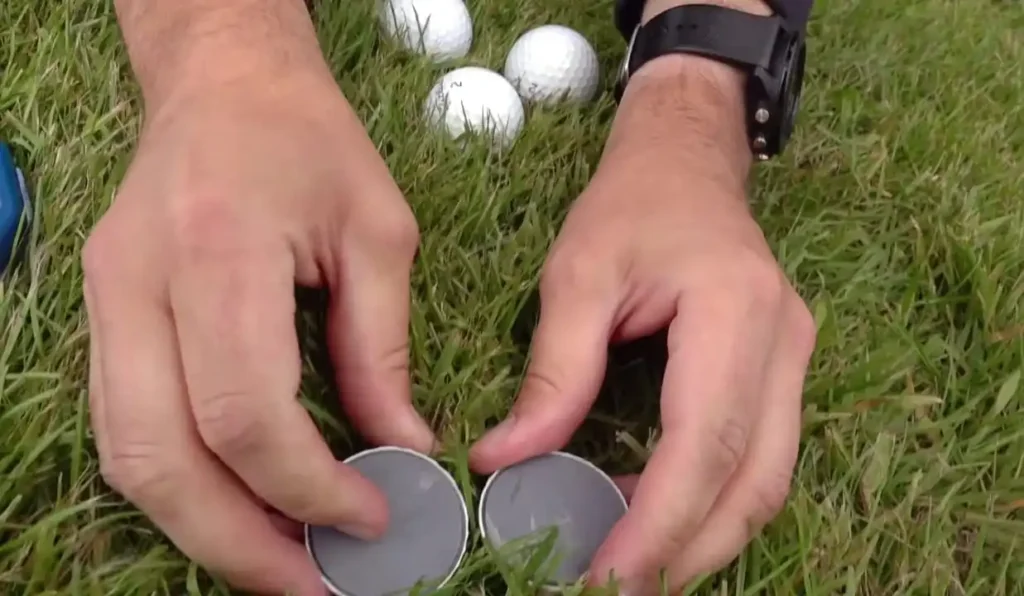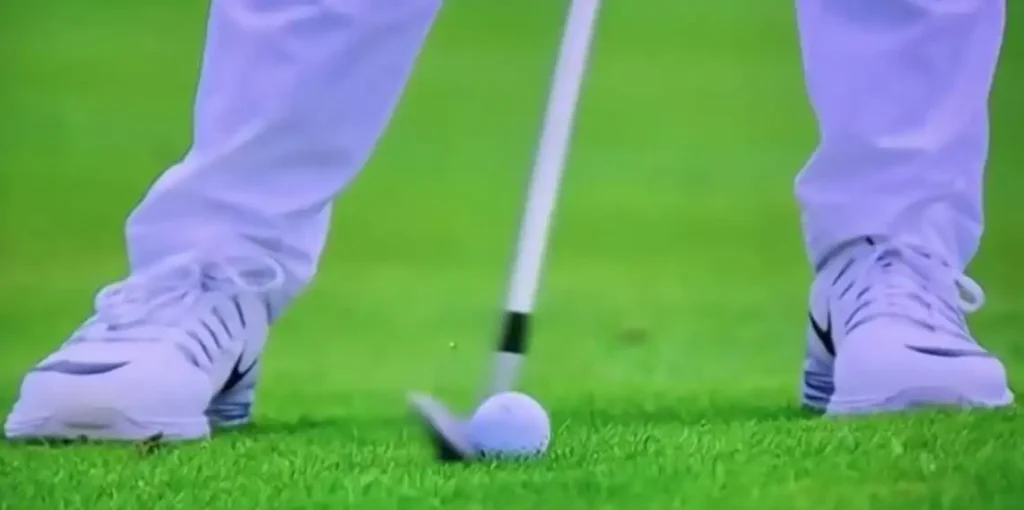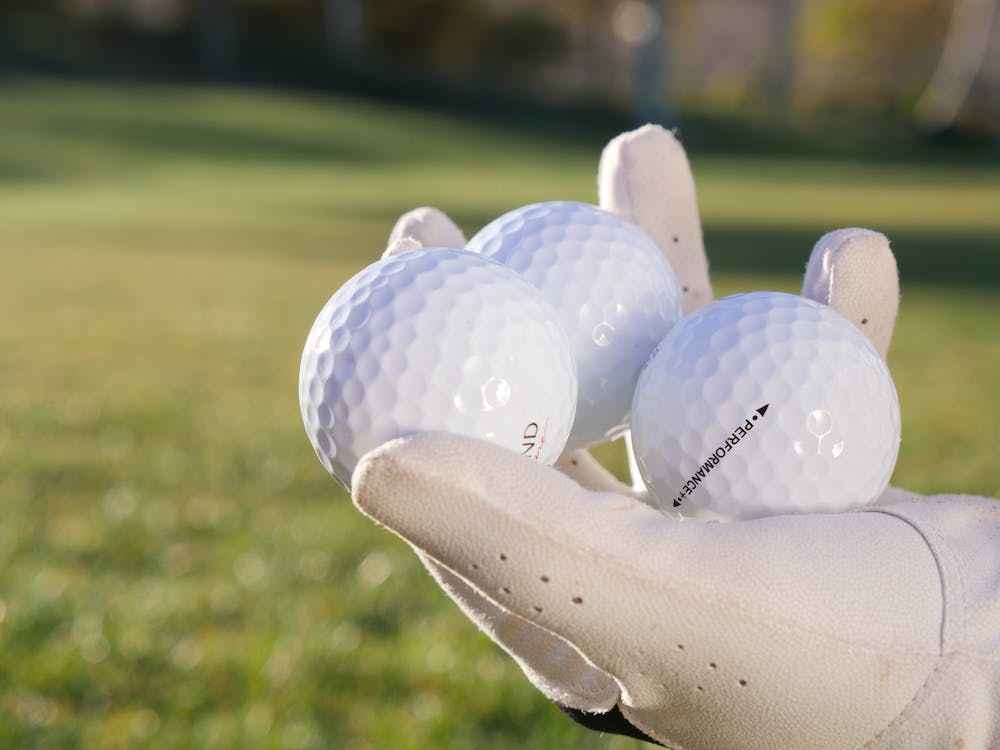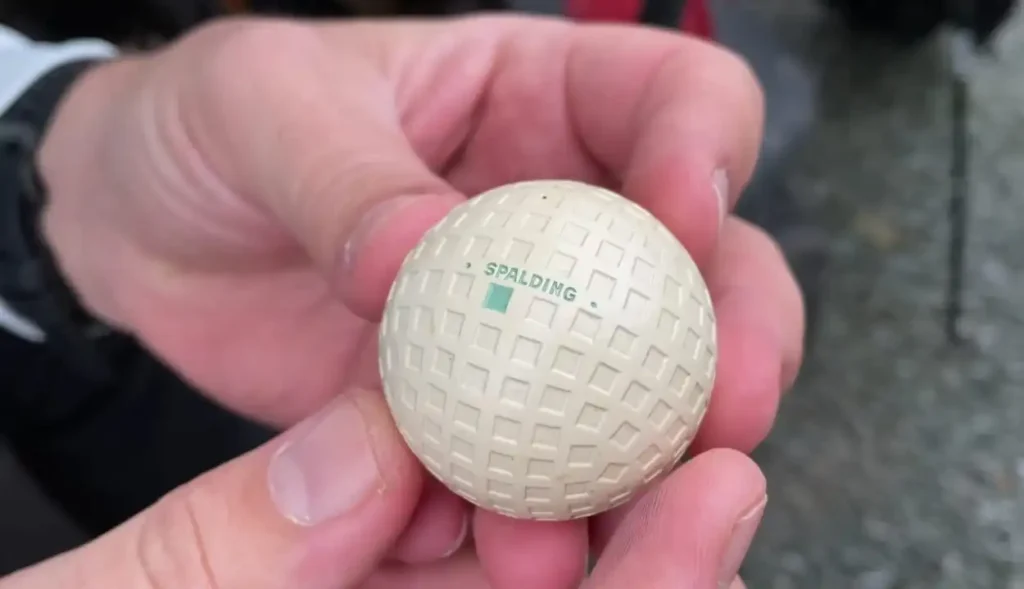So, you wanna one-up your game and become a more accomplished player? You may consider improving your skills with golf balls for practice and other accessories of a similar nature. A lot of golfers argue, however, that it’s better to use the same golf balls you’d use in a serious game to practice your putting skills. So, which balls should you use to hone your golfing skills? Is it better to use regular balls like a regular Joe or should you switch to using Pro V1s even for practice sessions? In this article, we will settle the “practice golf balls vs regular ones” debate.
Let’s look into the difference between range balls and regular golf balls to better understand this problem. Or, you may switch to practicing without a golf ball, as explained in this Forbes article. But let’s not get distracted by the availability of different practice techniques for modern golfers. We’ll only discuss how regular golf balls are different from the ones specifically designed for a practice session.

Practice Golf Balls VS Regular Golf Balls
Understanding the Nature of Practice Golf Balls
We’ve written a few articles on these bad boys before. Practice balls are manufactured to be used in a practice session; they don’t travel the same distance as a normal ball would and are much safer (i.e., you can use some of them around kids). Normally, you lose 10 to 20 yards by using a practice golf ball. Golf balls for practice are filled with lightweight stuff like foam. So, are they any good? First, we will have to discuss their nature deeply so we can move on to the much-awaited “practice golf balls vs regular ones” debate.
Lightweight Construction for Precision
Practice golf balls are designed with a focus on precision and skill enhancement. They usually feature a lightweight and plastic composition, crafted to facilitate controlled shots and targeted practice.
Soft Materials for Controlled Distances
The materials used in practice balls are intentionally softer, curbing their travel distances. For instance, consider golf practice foam balls. This attribute proves beneficial for golfers aiming to bolster their skills, providing a controlled environment for shot development without the concern of excessive ball flight.
Magnifying Feedback on Shot Execution
Practice balls serve as amplifiers of golfers’ shot execution. Any undesirable hook, slice, or topspin becomes more pronounced, offering valuable feedback for players looking to refine their swings and improve overall performance. Now, you can better understand the difference between a range ball vs regular ball.
Contrasting Characteristics of Regular Golf Balls
So, what are these regular golf balls we’re talking about? This article seeks to discuss the very heated debate on practice golf balls vs regular golf balls. That’s why we gotta first determine exactly what sort of a golf ball identifies as “normal” or “traditional”. This will help you learn the difference between practice and regular golf balls, helping us realize which of these options is better for our practice sessions.
Rigorous Standards and Construction
Regular golf balls adhere to stringent standards set by organizations like the USGA. Crafted from 100% rubber or solid Surlyn, these balls boast specific mass, diameter, and performance parameters, ensuring uniformity across the golfing landscape. That’s how you get a very strict, normal, and regular golf ball, fit for a round on the green.
Performance Metrics and Specifications
Regular golf balls are engineered to meet precise velocity, distance, and symmetry limits. Governed by rules laid out by the USGA, these balls undergo comprehensive testing to guarantee consistency in performance, making them suitable for competitive play. That’s why any version of Titleist Pro V1 you’ll buy in American stores will give you the same results.
Varied Options and Acceptance in Tournaments
Unlike practice balls, some regular golf balls, such as the Titleist Pro V1, conform to USGA rules despite having cosmetic blemishes. But this allows for their acceptance in club competitions, offering golfers a high-performance option with tournament credibility. Hopefully, now you can get the difference between practice golf balls vs regular dimpled spheres.
Dissecting the Distance Dynamics
We’ve discussed normal golf balls and explored the idea behind golf practice foam balls. So, what’s the difference between range balls and regular golf balls, and which one’s better for a practice session? How would you settle the “range ball vs regular ball” debate? Well, we could take the distance-dynamics route and dissect how far both of these spheres travel.
Just so you know, professional golfers don’t rely on soft golf balls for practice; they use the same “normal” spheres even when they’re training. So, disregard what they do in case ‘cause you’re just a normie. Think like an average person – and not a professional, in this regard – before choosing your best ball for practice.
Decoding the Range Discrepancy
Practice golf balls are known to travel shorter distances compared to their regular counterparts. According to insights from Quora, these distances can be 10–20 yards less than those covered by regular golf balls. The variance is contingent on factors like usage and wear. However, you don’t have to walk a lot to recoup these balls or lose them. This is another reason why the very old “practice golf balls vs regular ones” goes in the former’s favor.
The Overall Distance Standard
This standard for golf balls, set at 317 yards with a tolerance of 3 yards, further emphasizes the divergent nature of practice and regular golf balls. Rigorous testing under specific launch conditions underscores the performance disparities. You wouldn’t expect golf practice foam balls so act this way. So, the overall distance standard is a marked difference between practice and regular golf balls.
Limited Travel Distance
To create a controlled practice environment, these balls are engineered to travel no farther than 40 yards. This restricted distance allows players to focus on precision and shot control without the worry of excessive travel. Now, you have an idea which among practice golf balls vs regular spheres is the best one for your training session. Using foam-filled balls means no more wear and tear for your trophy Pro V1s.
Range Balls: Bridging The Gap
If you wanna better understand the “range ball vs regular ball” debate then let’s bridge the gap here, folks. We’ll help you understand the difference between practice golf balls vs regular golf balls here. So, here’s what you gotta do:
Assessing Range Ball Performance
Range balls occupy a unique space in the golf ball spectrum. While they vary widely in distance performance, their durability and cost-effectiveness make them suitable for driving range practice. However, their limitations in mimicking regular ball flight dynamics are evident.
Spin Discrepancies and Ball Flight Dynamics
Range balls, characterized by a harder feel and reduced spin compared to premium balls, showcase notable differences, especially at higher swing speeds. These variances impact the height and distance of shots, warranting consideration for golfers fine-tuning their game.

Types of Practice Golf Balls
So, which golf balls for practice should you use? We’ve discussed the “practice golf balls vs regular golf balls” debate here. It’s important to go through both of these options to understand the two options in a better way. Practice golf balls come in various types, each catering to different preferences and skill levels. You can, for example, read our article on golf practice foam balls. Understanding the distinctions between these types can help golfers choose the right practice ball for their needs. Here are some common types:
Foam Golf Balls
Description
Lightweight and made of soft foam material.
Usage
Ideal for indoor practice and short-game improvement.
Benefits
Safe for indoor use, won’t damage clubs, and is cost-effective.
Plastic Golf Balls
Description
Constructed from durable plastic materials.
Usage
Suitable for indoor and outdoor practice, especially on harder surfaces.
Benefits
More durable than foam balls, is affordable, and won’t damage clubs.
Rubber Golf Balls
Description
Heavier and made of rubber for increased durability.
Usage
Outdoor practice, mimicking the feel of real golf balls.
Benefits
Better flight simulation, suitable for outdoor use, and long-lasting.
Regular Golf Balls for Practice
Description
Similar to standard golf balls but may have cosmetic blemishes.
Usage
Practice on the course or driving range.
Benefits
Mimics the feel and performance of regular golf balls.
Tour-Level Practice Golf Balls
Description
High-quality balls with minor imperfections are sold at a lower price.
Usage
Suitable for serious practice, especially for players accustomed to tour-level balls.
Benefits
Offers performance similar to premium balls at a reduced cost.
Specialized Practice Balls
Description
Tailored for specific aspects like putting or swing analysis.
Usage
Targeted practice sessions to improve specific skills.
Benefits
Designed to address particular areas of the game for amateur golfers.
Types of Regular Golf Balls
Did you know that hitting 50 balls is the minimum when you’re practicing your golfing skills? You can either go with foam-filled spheres to one-up your game or hit traditional golf balls. Well, this article will explain to you which regular balls are ideal for a practice session. In short, regular golf balls come in various types, each designed to offer distinct performance characteristics suited to different players’ preferences and skill levels. Understanding these types can help golfers make informed decisions when selecting the right ball for their game, and settle the “practice golf balls vs regular ones” successfully. Here are common types of regular golf balls:
Two-Piece Golf Balls
Construction
Consists of a solid rubber core and a durable cover.
Characteristics
Provides maximum distance, low spin, and durability.
Suitable For
Golfers with slower swing speeds seek distance and durability.
Three-Piece Golf Balls
Construction
Core, mantle layer, and outer cover.
Characteristics
Balances distance, control, and spin.
Suitable For
Players looking for a balance between distance and control.
Tour-Level Golf Balls
Construction
Multi-layer design with a soft urethane cover.
Characteristics
High spin, control, and feel.
Suitable For
Advanced players with higher swing speeds who prioritize control.
Distance Golf Balls
Construction
Two-piece design with emphasis on a large, solid core.
Characteristics
Maximum distance, low spin, and reduced control.
Suitable For
Golfers seek maximum distance, especially those with higher swing speeds.
Low-Compression Golf Balls
Construction
Softcore is designed for lower compression.
Characteristics
Enhanced feel, ideal for slower swing speeds.
Suitable For
Players with moderate to slow swing speeds looking for a softer feel.
High-Compression Golf Balls
Construction
Firm core designed for higher compression.
Characteristics
Greater distance and control, suitable for faster swing speeds.
Suitable For
Players with higher swing speeds seek distance and control.
Surlyn-Covered Golf Balls
Cover Material
Surlyn is a durable ionomer resin.
Characteristics
Increased durability, straighter flight.
Suitable For
Golfers prioritize durability and a straighter.

Conclusion: Choosing the Right Ball For Your Game
This article settles the debate of “practice golf balls vs regular golf balls” once and for all. Which one of these is the best option for a practice session? Well, practice golf balls are designed for a limited distance. That’s why beginners should stick with foam-filled golf balls for practice to hone their skills. Pro golfers, however, don’t use golf practice foam balls; they train with traditional Pro V1s. So, when choosing between a range ball vs regular ball, make sure you take into account the different factors making these two balls different from each other. That’s how you can find out which dimpled sphere is your best pal out there on the grass.
FAQs – Practice Golf Balls VS Regular Golf Balls
1. What is the difference between practice golf balls and regular golf balls?
Practice golf balls differ from regular golf balls in various aspects. Practice balls are designed with a lightweight construction, and softer materials, and provide amplified feedback on shot execution. Regular golf balls adhere to strict standards, featuring diverse materials and specifications, making them suitable for competitive play.
2. Are foam golf balls good for practice?
Foam golf balls are indeed suitable for practice. Their lightweight and soft construction makes them safe for indoor use, and they are ideal for honing short-game skills. However, they may not replicate the feel and flight characteristics of regular golf balls accurately.
3. Do range balls go shorter?
Yes, range balls typically go shorter than regular golf balls. The distance variation can range from 10 to 20 yards less than that covered by regular golf balls. This discrepancy is influenced by factors such as the construction of range balls, usage, and wear.
4. Are range balls different from practice balls?
Range balls and practice balls are terms often used interchangeably, but they can refer to different things. Range balls are specifically designed for use on driving ranges, featuring durability and cost-effectiveness. Practice balls, on the other hand, can encompass various types, including foam or lightweight plastic balls, tailored for skill development.
5. How much shorter do range balls go?
Range balls are known to go shorter than regular golf balls, and the difference can be in the range of 10 to 20 yards. Factors influencing this variance include the materials used, the design for durability, and the overall construction that differs from that of regular golf balls.



